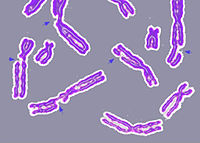
Photo from wikipedia
ABSTRACT Introduction: Translesion synthesis (TLS) is a DNA damage tolerance (DDT) mechanism that employs error-prone polymerases to bypass replication blocking DNA lesions, contributing to a gain in mutagenesis and chemo-resistance.… Click to show full abstract
ABSTRACT Introduction: Translesion synthesis (TLS) is a DNA damage tolerance (DDT) mechanism that employs error-prone polymerases to bypass replication blocking DNA lesions, contributing to a gain in mutagenesis and chemo-resistance. However, recent findings illustrate an emerging role for TLS in replication gap suppression (RGS), distinct from its role in post-replication gap filling. Here, TLS protects cells from replication stress (RS)-induced toxic single-stranded DNA (ssDNA) gaps that accumulate in the wake of active replication. Intriguingly, TLS-mediated RGS is specifically observed in several cancer cell lines and contributes to their survival. Thus, targeting TLS has the potential to uniquely eradicate tumors without harming non-cancer tissues. Areas Covered: This review provides an innovative perspective on the role of TLS beyond its canonical function of lesion bypass or post-replicative gap filling. We provide a comprehensive analysis that underscores the emerging role of TLS as a cancer adaptation necessary to overcome the replication stress response (RSR), an anti-cancer barrier. Expert Opinion: TLS RGS is critical for tumorigenesis and is a new hallmark of cancer. Although the exact mechanism and extent of TLS dependency in cancer is still emerging, TLS inhibitors have shown promise as an anti-cancer therapy in selectively targeting this unique cancer vulnerability.
Journal Title: Expert Opinion on Therapeutic Targets
Year Published: 2021
Link to full text (if available)
Share on Social Media: Sign Up to like & get
recommendations!